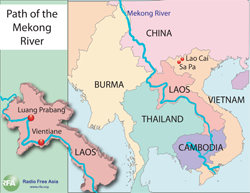




VIENTIANE—Landslides caused by the worst flooding in decades have killed four people in Laos, but water levels are now declining.
Major Lao transportation routes shut down and electricity was cut off in flooded suburban areas, including the popular tourist locale Luang Prabang.
Water levels in Vientiane declined Wednesday from flood stage, but the Mekong River Commission (MRC) acknowledged that other areas will remain above alarm and flood stages for the next two to three days.
River towns in Cambodia face increasing water levels over the next few days as well.
Farm risk
The MRC, an intergovernmental body charged with sustainable development and water resource management of the Mekong River, warned that local agriculture would likely be affected.
While some unharvested crops could be at risk, “the impact on agriculture is expected to be limited, as the affected areas are usually under rice cultivation,” it said.
With food prices already surging worldwide, a poor harvest could take a steep toll on Laos, already one of the world’s poorest countries. The central government has called on merchants to help keep food prices stable.
Bad weather is expected to persist in the lower Mekong Basin until the end of September, according to Lao meteorologists.

Massive rainfall and overflowing rivers have killed at least 130 people in the towns of Lao Cai and Sa Pa in the north of neighboring Vietnam. Flooding has also hit Thailand, Cambodia, and Burma.
Other factors
Both the MRC and a senior Lao official downplayed charges that the flooding was worsened by the release of Chinese-owned dams and by the blasting of reefs in the upper reaches of the Mekong.
“Blaming China [for the flooding] without solid evidence would only hurt relations between the two countries,” the Lao deputy chief of water resources said.
MRC Secretariat Planning Director Boriboon Sanasisan described this year’s flooding as major.
“This year’s flood is a big one, to some extent,” he said in an interview.
“We cannot blame the Chinese dams for the Mekong flooding this year, because the Chinese dams have no reservoirs. They are overflow dams,” he said.
Original reporting by RFA's Lao service. Translated by Thao-Mo Bounnak. Service director: Viengay Luangkhot. Executive producer: Susan Lavery. Written in English by Joshua Lipes. Edited by Sarah Jackson-Han.